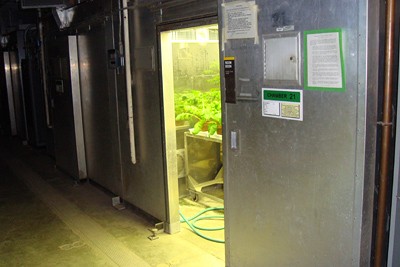CALS' growth chambers get a green makeover that will save $156K a year in energy costs
By Lauren Chambliss
Cornell's oldest and least energy-efficient environmental growth chambers -- some dating back to the 1950s -- that are used for research in the College of Agriculture and Life Sciences (CALS) will soon get an extensive makeover that are expected to save $156,000 annually in electricity costs and reduce annual carbon dioxide equivalent emissions by an estimated 721 tons, thanks to a timely grant from the New York State Research and Development Authority (NYSERDA).
NYSERDA awarded about $365,000 toward the $600,000 project, which will upgrade 26 of the college's decades-old growth chambers with 21st-century lighting and control technology. Cornell and the Cornell University Agricultural Experiment Station (CUAES), which operates the growth chambers, are footing the rest of the bill.
Growth chambers are used by researchers for growing and conducting experiments with plants and insects and typically require high-intensity lighting and temperature control. Some of the older chambers are essentially "energy sinks," costing as much as $26,000 a year to run, because of antiquated light and systems control technology manufactured when energy use was not a consideration, says Nick Van Eck, who supervises the CUAES growth chamber crew.
The chamber project also includes retrofits for 12 CALS environmental chambers without lighting (non-growth chambers), which are tightly controlled refrigeration units used for the storage and/or manipulation of cultures, bacteria and other substances. These retrofits will allow for some variability in the temperature, potentially saving up to 75 percent on electricity usage, without negatively affecting research projects.
Cornell's Department of Utilities and Energy Management, which applied for the grant and is leading this project collaboratively with CUAES, forecast the dramatic reductions in both energy use and carbon footprint based on pilot retrofit work already completed.
The growth chambers, mostly housed in the Ken Post and Dimock Laboratories, were audited and inventoried by Van Eck over the past year in an effort to identify the most inefficient units for upgrade and/or removal. After the audit, CUAES scrapped 14 of the 100-plus growth chambers and shut off another 10 because they were old and unreliable.
"In addition to providing a significant energy savings to the university, retrofitting these chambers also benefits our researchers by providing more reliable precision control, which is critically important to many projects," says Michael Hoffmann, director of the CUAES.
Lauren Chambliss is assistant director for communications for CUAES.
Get Cornell news delivered right to your inbox.
Subscribe